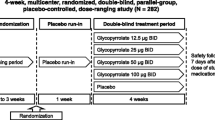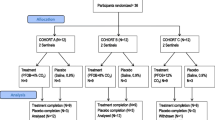Summary
The effect of intravenous theophylline on the outcome of inhospital treatment of acute bronchospasm has been assessed, comparing the results achieved by computer-assisted dosing, designed to achieve and maintain a serum theophylline level of 16 μg · ml−1 (10 patients) with those of unaided physicians (15 control patients). The outcome measures compared were clinical improvement, peak expiratory flow rate and serum theophylline concentration.
Loading doses of theophylline in the control and computer groups were: 167 and 437 mg, respectively. Initial serum theophylline concentrations, measured 20 min after the loading dose, were 13.6 and 17.0 μg · ml−1 in the control and computer groups, respectively. In patients who had not received theophylline prior to admission, loading doses and initial concentrations were: 200 mg and 9.4 μg · ml−1 in the control group (n = 5) versus 613 mg and 15.7 μg · ml−1 in the computer group (n = 4), respectively.
During maintenance therapy, serum theophylline concentrations were kept in the therapeutic range (10–20 μg · ml−1) throughout 51 % and 77 % of the hospitalisation period, in the control and computer groups, respectively. There were no differences between the two groups in the rate or extent of clinical improvement or in change in peak expiratory flow rate.
The computer assisted theophylline dosing regimen outperformed that of the unaided physicians in achieving and maintaining therapeutic serum theophylline concentrations in acute bronchospasm. There was no correlation between clinical outcome and serum theophylline concentration, but this may have been due to the small sample size and modest difference in serum theophylline between the two groups. The findings serve as an additional argument in favour of the trend away from reliance on theophylline as first line therapy in acute bronchospasm.
Similar content being viewed by others
References
Barnes PJ (1989) A new approach to the treatment of asthma. N Engl J Med 321: 1517–1527
Rossing TH (1989) Methylxanthines in 1989. Ann Intern Med 110: 502–504
Lam A, Newhouse MT (1990) Managment of asthma and chronic airflow limitation. Are methylxanthines obsolete. Chest 98: 44–52
Weinberger M (1989) The value of theophylline for asthma. Ann Allerg 63: 1–3
Newhouse MT (1990) Is Theophylline Obsolete. Chest 98: 1–2
Addis GJ (1990) Theophylline in the management of airflow obstruction. Br Med J 300: 928–929
Rossing TH, Fanta CH, Goldstein DH, Snapper JR, McFadden ER (1980) Emergency therapy of asthma: comparison of the acute effects of parenteral and inhaled sympathomimetics and infused aminophylline. Am Rev Respir Dis 122: 365–371
Jenne JW (1990) Theophylline Is No More Obsolete Than “Two Puffs qid” of Current Beta2 Agonists. Chest 98: 3–4
Racineux JL, Troussier J, Tureant A (1981) Comparison of bronchodilator effects of salbutamol and theophylline. Bull Fur Physiopathol Respir 17: 799–806
Mountain RD, Neff TA (1984) Oral theophylline intoxication: a serious error of patients and physician understanding. Arch Intern Med 144: 724–727
Woodcock AA, Johnson MA, Geddes DM (1983) Theophylline prescribing, serum concentrations, and toxicity. Lancet 11: 610–612
Johnston IDA (1990) Difficult drugs to use, few clinical indications. Br Med J 300: 929–931
Peck C, Brown W, Sheiner L (1980) A microcomputer drug (theophylline) dosing program which assists and teaches physicians. Comp Appl Med Care 4: 988–994
Peck CC (1989) Bedside clinical pharmacokinetics: simple techniques for individualizing drug therapy. Pharmacometrics Press, Rockville
Becker AB, Nelson NA, Simons FER (1984) The Pulmonary Index: assessment of a clinical score for asthma. AJDC 138: 574–576
American Thoracic Society (1987) Standards for the diagnosis and care of patients with chronic obstructive pulmonary disease (COPD) and asthma. Am Rev Respir Dis 136: 225–244
Mitenko P, Ogilvie R (1973) Rational intravenous doses of theophylline. N Engl J Med 289: 600–603
Hendeles L, Massanari M, Weinberger M (1985) Update of the Pharmacodynamics and Pharmacokinetics of Theophylline. Chest 88: 103s-111s
Littenberg B (1988). Aminophylline treatment in severe acute asthma: a meta-analysis. JAMA 259: 1678–1684
Newhouse MT, Dolovich MB (1986) Control of asthma by aerosols. N Engl J Med 315: 870–874
Fanta CH, Rossing TH, McFadden ER (1983) Glucocorticoids in acute asthma: a critical controlled trial. Am J Med 74: 845–851
Pauwels R (1989) Modes of action of theophylline: new tricks for an old dog. In: Vermeire P, Demedts M, Yernault C (eds). Progress in asthma and COPD; Elsevier, Amsterdam, pp 151–160
Naclerio RM, Bartenfeld D, Proud D (1985) Theophylline reduces the response to nasal challenge with antigen. Am J Med 79: 43
Hill NS (1988) The use of theophylline in irreversible chronic obstructive pulmonary disease. Arch Intern Med 148: 2579–2584
Murciano D, Aubier M, Lecocguic Y, Pariente R (1984) Effects of theophylline on diaphragmatic srength and fatigue in patients with chronic obstrutive pulmonary disease. N Engl J Med 311: 349–353
Vozeh S, Kewitz G, Perruchoud A, Tschan M, Kopp C, Heitz M, Follath F (1982) Theophylline serum concentration and therapeutic effect in severe acute bronchial obstruction: the optimal use of intravenously administered aminophylline. Am Rev Respir Dis 125: 181–184
Bukowskyj M (1988) Theophylline: an overview. Rational Drug Ther 22: 1–5
Sakamoto Y, Kabe J, Horai Y (1989) Effect of theophylline on improvement of the pulmonary function in the treatment of acute episodes of asthma: the influence of the severity of acute asthma. Ann Allerg 63: 21–27
Author information
Authors and Affiliations
Rights and permissions
About this article
Cite this article
Verner, D., Seligmann, H., Platt, S. et al. Computer assisted design of a theophylline dosing regimen in acute bronchospasm: Serum concentrations and clinical outcome. Eur J Clin Pharmacol 43, 29–33 (1992). https://doi.org/10.1007/BF02280750
Received:
Accepted:
Issue Date:
DOI: https://doi.org/10.1007/BF02280750




